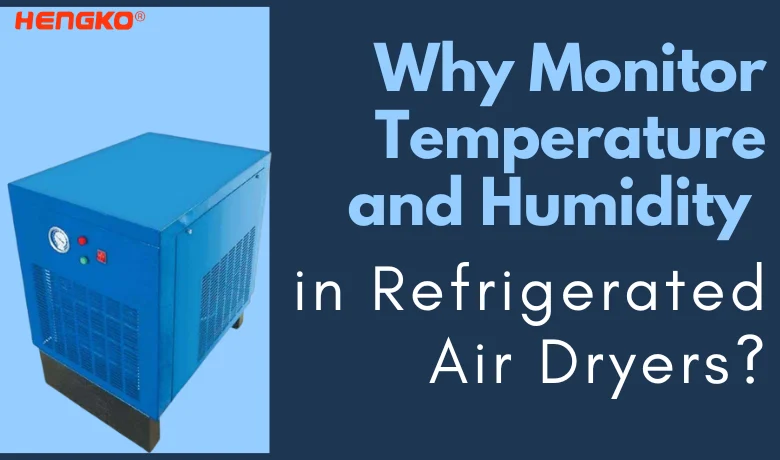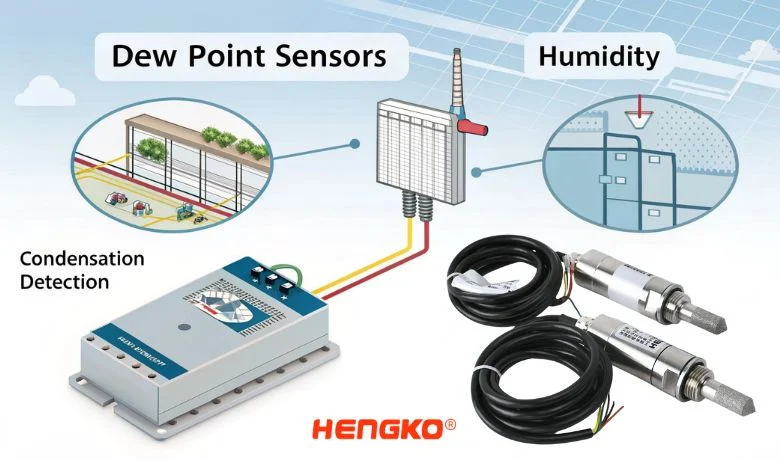Einführung
Compressed air is often referred to as the “fourth utility” in modern industry, alongside electricity, water, and gas. Yet, one of the most common issues facing compressed air systems is moisture. When untreated, moisture can lead to corrosion, blocked pipelines, damaged pneumatic equipment, and compromised product quality. To address this, refrigerated air dryers—commonly known as “cold dryers”—are widely used as an efficient means of reducing moisture in compressed air.
But while refrigerated dryers are effective, their performance depends heavily on stable environmental control. This is where temperature and humidity transmitters come into play. By continuously monitoring critical parameters, these transmitters ensure that dryers operate within optimal conditions, safeguarding both equipment and end products.
Why Monitoring Matters in Refrigerated Air Dryers
Refrigerated air dryers are the most widely used solution for removing moisture from compressed air. They work by cooling the air so that water vapor condenses and can be separated. However, the efficiency and reliability of this process depend heavily on stable environmental control. Without proper monitoring of temperature and humidity, several problems can occur:
·Risk of Ice Formation: If the cooling temperature drops too low, ice can form inside the evaporator, blocking airflow and potentially damaging components.
·Insufficient Drying:If cooling is unstable or humidity rises, the dryer may fail to remove enough moisture, leaving compressed air prone to corrosion and contamination.
·Quality Fluctuations: Variations in dew point or outlet air conditions can lead to inconsistent air quality, putting sensitive applications—such as food processing, pharmaceuticals, or electronics—at risk.
By continuously monitoring temperature and humidity, operators can keep the dryer within safe operating limits, respond to anomalies in real time, and ensure consistent compressed air quality. This not only protects equipment but also reduces downtime, lowers maintenance costs, and improves energy efficiency across the system.
Temperature Monitoring in Refrigerated Dryers
Temperature is the backbone of refrigerated dryer operation. Monitoring plays several roles:
·Evaporator Temperature Control
The evaporator is where the compressed air is cooled by the refrigeration circuit. If its temperature drops below 0 °C, frost or ice can form, obstructing the system. Temperature transmitters help maintain the evaporator in the safe range of 0–5 °C.
·Outlet Air Temperature
After drying, compressed air should not be excessively cold. If outlet temperature is too low, pipelines may condense water on their surfaces. If it is too high, drying efficiency decreases. Continuous monitoring ensures outlet air remains within safe operating limits.
·Feedback for Control Systems
Temperature data can be fed directly into a PLC or controller, enabling automatic regulation of compressors, fans, or expansion valves. This not only stabilizes the process but also improves energy efficiency.
Humidity Monitoring and Dew Point Control
While temperature ensures proper cooling, humidity monitoring verifies the actual quality of the compressed air.
·Dew Point as a Performance Indicator
The dew point represents the temperature at which moisture condenses. For refrigerated dryers, a typical pressure dew point (PDP) of 2–10 °C is sufficient for most industrial applications. By tracking the dew point, operators know whether the dryer is effectively removing moisture.
·Real-Time Alarms
When dew point rises above the set threshold, humidity transmitters can trigger alarms or activate backup drying equipment. This prevents moisture-related damage before it impacts downstream systems.
·Energy Savings Through Control
Advanced systems use dew-point-dependent control, adjusting the refrigeration system only when required. This approach can significantly reduce energy consumption without compromising air quality.
Advantages of Temperature and Humidity Transmitters
Modern transmitters are designed with features that make them particularly valuable in refrigerated dryer applications:
·High Precision and Stability
Transmitters can achieve accuracies of ±0.2 °C for temperature and ±2% RH for humidity, ensuring reliable monitoring even in harsh, high-humidity conditions.
·Durability in Extreme Environments
Specialized designs allow transmitters to operate in environments above 95% RH, maintaining long-term performance without sensor drift.
·Flexible Output Options
With analog signals such as 4–20 mA and digital outputs like Modbus/RS485, transmitters integrate seamlessly with PLC, SCADA, or cloud-based monitoring systems.
·Predictive Maintenance
Historical data from transmitters can reveal trends, such as gradual increases in dew point or outlet temperature. This allows operators to identify declining dryer performance and schedule maintenance before failures occur.
·Industrial Benefits of Monitoring
The benefits of integrating temperature and humidity transmitters into refrigerated dryers extend across industries:
·Improved Air Quality
Moisture is removed more consistently, reducing risks of corrosion, blockages, or microbial growth.
·Energy Efficiency
With precise monitoring, systems can run only as hard as necessary, cutting electricity costs significantly.
·Extended Equipment Lifespan
Preventing ice formation and overheating reduces mechanical stress on compressors, heat exchangers, and piping.
·Compliance with Standards
Industries like food processing, pharmaceuticals, and electronics require adherence to strict compressed air quality standards (e.g., ISO 8573). Monitoring ensures compliance and avoids costly downtime.
Example Applications
·Pharmaceutical Manufacturing: Monitoring ensures air purity for drug production and storage, maintaining compliance with GMP standards.
·Food and Beverage:**Stable drying conditions prevent bacterial growth and preserve food quality.
·Electronics: Dry nitrogen or compressed air is often required; precise dew point control prevents condensation that could damage circuits.
·General Industry: ****Pneumatic tools and actuators perform reliably and last longer when supplied with dry, stable air.
Schlussfolgerung
Refrigerated air dryers are indispensable in compressed air systems, but their effectiveness depends on careful control of temperature and humidity. By integrating high-performance transmitters, industries can achieve:
·Reliable and consistent compressed air quality
·Reduced energy consumption
·Extended equipment lifetime
·Compliance with stringent industry requirements
In an era where efficiency and reliability define competitiveness, temperature and humidity monitoring is no longer optional—it is a necessity. For operators seeking to safeguard their systems, investing in advanced transmitter technology is a small step that delivers enormous long-term value.
Looking to safeguard your compressed air systems and ensure consistent performance?
Ready to safeguard your compressed air systems and ensure consistent performance? Contact HENGKO today to learn more about our temperature and humidity transmitters—and discover how we can optimize your refrigerated air dryer operations.”





